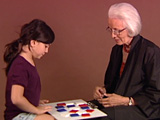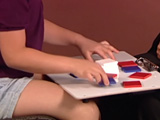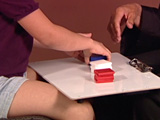|
|
|
|
Developed by Lea Hyvärinen, M.D.

We can see in bright daylight and in twilight. In daylight vision (photopic vision) we use cone cells. Activity in the cone cell pathway inhibits the rod cell pathway. When the luminance level becomes lower, input from cone cells decreases and input from rod cells increases (mesopic vision). When the luminance level decreases further, the cone cells’ contribution to vision stops, colours disappear. The image is in different shades of grey because rod cells do not convey colour differences (scotopic vision). When we enter a darker place it takes a few seconds before we start to see colours at the lower luminance level. This is called cone adaptation time.
In retinal degenerations cone cell adaptation time may become longer than normal quite early. Therefore the CONE Adaptation test can be used for screening of retinitis pigmentosa and follow-up of retinal function.
The Cone Adaptation Test (#252900) consists of fifteen 5 x 5 cm (2 x 2 in) red, blue and white plastic chips designed to help parents, teachers and doctors become aware of a child's visual difficulties in twilight. The test situation is not a formal test of night vision, but gives useful information on visual adaptation to lighting changes.



When we enter a room that is darker than the room where we were, during a few seconds, the room looks dark and then we start to see comfortably. This rapid adaptation to a lower luminance level is possible because cone cells adapt quickly within the range of their adaptation capability. Rod cell adaptation to very dim light is much slower.
In every day life we need to change our adaptation in the adaptation range of cone cells more often than in the range of rod cells. Actually, in cities children and many adult persons rarely are in pure scotopic conditions, i.e. where only rod cells function. There is a wide range of luminance levels where both cone and rod cells function. In that range cone adaptation is important because it is faster than the rod adaptation. If colours can be perceived we are within the range of cone cell function. Therefore perception of colours can be used to assess the speed of cone cell adaptation. This was first suggested by Thornton.
Instructions
-
Training before the test situation
-
If the child is able to sort colours, mix up the chips on a dark coloured table or cloth and direct him or her to put them into three separate groups: red, blue and white. The child starts with the white chips.Explain that next time they should be sorted into these three groups as soon as possible after the lights have been dimmed.
-
Dim the lights so the child can still see the colours without difficulty and ask the child to sort the chips. Again, the child starts with the white chips. Mix the chips again and turn up the lights to the usual room illumination. Tell the child that next time the lights will be very dim but the chips should be sorted as before. This training is necessary so that the child starts to sort the chips immediately when the white chips can be seen.
CONE Adaptation Test
-
Now dim the lights to a level where you can barely see the colours of the chips after an adaptation period of a few (4-5) seconds. (This luminance level you have to define earlier; usually it is created with a lamp in a corner of the room behind a shade.) The child will pick the white chips first because they are the easiest to see and then will try to separate the blue chips from the red chips. If the child makes a mistake, never say anything about it. Mix the chips while in the dark and then turn up the lights to normal room illumination and repeat the play situation. If the child has difficulties in the twilight level of illumination, increase the illumination until the colours can be recognized within a few seconds. This is the minimum level of illumination that is adequate for comfortable visual communication and activities of daily life.
-
It may be that the child could start to perform in the test at the twilight level of illumination, if given more time. Include this in your observations. Do something that makes waiting in the dark pleasant, like telling a story for about 15-20 minutes. This is a good test situation for follow-up of the condition. At the same time it demonstrates the child's (person's) disability to function in situations where (s)he should find something from a darker place, like a closet. Nobody can wait for 15-20 minutes to start seeing objects in a closet. Such a person needs an extra light in the closet and a good torch/flash light.
You may use normal twilight situations like coming in from an evening walk and not turning on the room lights, but starting with the play situation immediately at that low luminance level.
Remember, changes in night and twilight vision occur so slowly that the child does not notice them. This simple play situation helps to keep you aware of the child's present visual adaptation level to lighting changes. This includes both speed of adaptation and the final adaptation level reached after a few seconds or longer adaptation to the dark. Remember to report your observations to the child's eye doctor.
This simple test situation can be made to a more formal test by standardizing the luminance levels. In the beginning of the test ask the child/person to look at a white surface for one minute. Use always the same white surface and the same lamp at the same distance so the adaptation to high luminance level is equal in all measurements. Define the mesopic luminance level in similar way, i.e. use a small light in a corner of the room behind the child and the same dark cloth each time.
[ Instructions I Paediatric Vision Tests I Vision Tests ]
This document was last modified on
